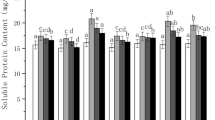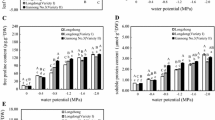Abstract
Acid deposition and temperature variation could lead to changes of physiological characteristics of plants in response to stress. In this paper, Medicago sativa CV. Dongmu–1 was investigated to test the effects of freeze-thaw circle and acid deposition upon the changes of osmotic adjustment substances, biological membrane permeability, and antioxidant enzymes. The experiment was conducted under laboratory conditions, and the seedlings were divided into four groups (group I: no treatment, group II: acid stressed only, group III: freeze-thaw stressed only, group IV: both freeze-thaw and acid stressed). Results indicated that under freeze-thaw circle and acid deposition, the contents of malondialdehyde (MDA) and proline increased respectively by 0.6~203.4 and 19.3~68.8% when compared with group I, while protein content declined by 4.1~31.7%, and the effects were even significant than freeze-thaw-only stressed groups. In the freeze-thaw process, superoxide dismutase (SOD) activity dropped at first and then increased with the increase of temperature, peaking at − 3 °C by 1118.45 U g−1; peroxidase (POD) activity showed a brief rise and declined rapidly below 0 °C. By increasing the potentials of antioxidant enzymes and MDA, the membrane lipid peroxidation inside alfalfa was prevented; meanwhile, several indexes changed adaptively in resisting hurts. Variation of SOD and POD was induced by the defense mechanism, which showed alfalfa’s satisfactory cold resistance and acid tolerance. Further research on acid deposition and freeze-thaw circle would be beneficial for the global cultivation of forage grass.





Similar content being viewed by others
References
Adem, G., Metin, T., Nurgul, K., Sefik Tufenkci, M., Kerim, M. C., Ertan, Y., & Sezai, E. (2016). Effects of bio-bor fertilizer applications on fruit yield, antioxidant enzyme activity and freeze injury of strawberry. Erwerbs Obstbau, 58, 177.
Chi, C., Ding, G. H., & Lian, Y. Q. (2007). Effect of low temperature stress on proline content and membrane permeability in three kind cold-season turfgrass. Chinese Agricultural Science Bulletin, 23(01), 101–104.
Fan, H. B. (2002). On worldwide acid rain research. Journal of Fujian College of Forestry, 22(4), 371–375.
Feng, Z. W. (2000). Impacts and control strategies of acid deposition on terrestrial ecosystems in China. Engineering Science, 2(9), 5–11.
Feng, C. J., Luo, X. Y., & Sha, W. (2005). Effect of low temperature stress on SOD, POD activity and proline content of alfalfa. Pratacultural Science, 22(6), 29–32.
Fleck, R. A., Day, J. G., & Clarke, K. J. (1990). Elucidation of the metabolic and structural basis for the cryopreservation recalcitrance of Vaucheria sessilis. CryoLetters, 20, 271–282.
Gao, Y., Qi, X. H., Yang, J. H., & Zheng, M. F. (2007). The response mechanism of cold stress in higher plants. Northern Horticulture, 10, 58–61.
Guy, C. L. (2003). Freezing tolerance of plants: current understanding and selected emerging concepts. Canadian Journal of Botany, 81, 1216–1223.
Jiang, X. M., Qin, Y., & Guo, G. Z. (2013). Effects of exogenous substances on seed germinationand chilling resistance of pepper under low temperature stress. Xinjiang Agricultural University, 50(12), 2266–2273.
Jing, Y., Jing, C., Li, Y. P., Huang, R., Lu, Q. W., Wang, X. T., Liu, L. J., Xu, Q. H., & Zhang, K. J. (2016). Salicylic acid-induced antioxidant protection against low temperature in cold-hardy winter wheat. Acta Physiologiae Plantarum, 38, 261.
Li, H. (1988). The state of acid rain in China. World Environment, (04):14–15.
Li, J. H., Yu, Q., & Dou, Z. J. (1985). The effect of free froline treated under low temperature during reproductive period of rice varieties. Journal of Central China Normal University, 3, 1–84.
Li, D., Tang, L., & Zhou, Q. (2008). Effect of the simulated acid rain on the soluble protein and proline contents of rice seeds during the germination. Journal of Safety and Environment, 08(5), 12–15.
Li, S. L., Jia, X. Y., & Li, Y. P. (2009). Research on the characteristics of leaves and cold tolerance of alfalfa by treating with Ca(NO3)2. Journal of Heilongjiang Bayi Agricultural University, 21(3), 9–11.
Liang, J., Mai, B. R., & Zheng, Y. F. (2008). Effects of simulated acid rain on the growth yield and quality of rape. Acta Ecologica Sinica, 28(1), 274–283.
Lin, L. D. (2008). Research on resistance to coldness of lawn grasses of cold season in chilly zones of the northeast. Journal of Qiqihar University, 24(3), 83–85.
Lin, S. Z., Li, X. P., & Zhang, Z. Y. (2002). The effects of cold acclimation on the freezing resistance and total soluble protein in Populus tomentosa seedlings. Scientia Silvae Sinicae, 18(6), 137–141.
Liu, X. H., & Hao, M. D. (2001). Effects of long-term plant Medicago sative Linn. on soil nitrogen nutrient. Chinese Journal of Ecology Agriculture, 24(4), 479–479.
Liu, Y. Q., Jiang, L., & Sun, L. H. (2005). Changes in some defensive enzyme activity induced by the piercing-sucking of brown plant hopper in rice. Journal of Plant Physiology and Molecular Biology, 31(6), 643–650.
Luo, X. Y., Feng, C. J., & Li, H. (2004). Study on changes of SOD and proline activity during low temperature stress on Medicago sativa L. cv. Zhaodong. Grassland of China, 26(04), 79–80.
Mao, G. L., & Xu, X. (2005). Studies on in vivo selection of salt-tolerant mutant of Lycium barbarum L. and its physiological and biochemical characteristics. Acta Bot. Boreal. -Occident.Sin, 25(2), 275–280.
McKay, H. M., & Mason, W. L. (1991). Physiological indicators of tolerance to cold storage in Sitka spruce and Douglas-fir seedlings. Canadian Journal of Forest Research, 21(6), 890–901.
Mohammad, H. S. M., Nematollah, E., Mohammad, M. A., Mostafa, A., Mostafa, A., & Mohammad, P. (2017). Molecular and physiological responses of Iranian Perennial ryegrass as affected by Trinexapac ethyl, Paclobutrazol and Abscisic acid under drought stress. Plant Physiology and Biochemistry, 111, 129–143.
Rasouli, S., Farkhondeh, M. M., Jafari, H. R., Suffling, R., Kiabi, B., & Yavari, A. R. (2012). Assessment of Ecological integrity in a landscape context using the Miankale peninsula of Northern Iran. International Journal of Environmental Research, 6(2), 443–450.
Shao, Y. R., Xu, J. X., & Xue, L. (2013). Effects of low temperature stress on physiological-biochemical indexes and photosynthetic characteristics of seedlings of four plant species. Acta Ecologica Sinica, 33(14), 4237–4247.
Shi, X. H., & Chen, Z. Y. (1996). Low temperature stress on SOD and its isoenzyme in detached citrus leaves. Bulletin of Botanical Researvh, 4, 384–386.
Shi, Y. H., Zhang, W. Y., & Yu, X. D. (2009). Effect of photoperiod on SOD and POD activities in alfalfa. Grassland and Turf, 01, 74–77.
Shi, X. H., Chen, Z. Y., Yang, H. Q., & Chen, A. (1996). Low temperature stress on SOD and its isoenzyme in detached citrus leaves. Acta Horticulturae Sinica, 23(4), 386–398.
Wang, X. K. (2010). Experiment principles and techniques of plantphysiology and biochemistry. Beijing: Higher Education Press.
Wang, W., & Li, Z. J. (2009). The study on changing regularity of several cold resistance indexes of alfalfa under low temperature stress, 6, 23-26. Northeast Normal University. (doctoral thesis)
Wang, R. Y., Ren, Y. S., & Yue, W. B. (2006). Effect of low temperature stress on the survival and physiological and biochemical indexes of alfalfa seedlings. ACIA Laser Biology Snice, 15(4), 342–348.
Wei, W. L., Cheng, J. M., Gao, Y., & Liu, W. (2010). Effects of different site conditions on alfalfa field and path analysis in arid area of Northern Weihe River Basin. Bulletin of Soil and Water Conservation, 30(5), 73–78.
Wu, J. H., Yang, L., & Sun, G. R. (2004). Generation of activated oxygen and change of cell defense enzyme activity in leaves of maize seedling under the stress of low temperature. Bulletin of Botanical Research, 24(04), 456–459.
Wu, H., Zhang, J. S., & Shi, J. Y. (2013). Physiological responses of cotton seedlings under low temperature stress. Acta Bot. Boreal. -Occident.Sin, 33(01), 74–82.
Xu, Z. H., Guo, D. P., Yu, L. Q., Zhao, M., Zhang, X., Li, D., Zheng, K. L., & Ye, Y. L. (2003). Molecular biological study on the action mechanism of rice allelochemicals against weeds. Chinese Journal of Applied Ecology, 14(5), 829–833.
Yang, X. J. (2006). Evaluation of cold resistance of alfalfa and its physiological responses to low temperature stress in autumn and winter. Beijing Forestry University. (doctoral thesis)
Yang, Y. H., Jiang, P. A., & Luo, M. (2005). Effects of planting Medicago sativa L on soil fertility. Arid Land Geography, 28(2), 248–251.
Ye, Y. X., Jin, J., & Qin, F. J. (2009). Effects of low temperature stress on superoxide dismutase activity of wheat, corn, radish seedlings. Chinese Agricultural Science Bulletin, 25(23), 244–248.
Yu, J., Cang, J., Li, Y. P., Huang, R., Lu, Q. W., Wang, X. T., Liu, L. J., Xu, Q. H., & Zhang, K. J. (2016). Salicylic acid-induced antioxidant protection against low temperature in cold-hardy winter wheat. Acta Physiologiae Plantarum, 38(11), 1–10.
Yuan, Y. S., Hu, Y., & Li, Y. X. (2014). Effects of simulated acid rain stress on growth and physiological characteristics in leaves of Acanthopanan trifoliatus (L.) Merr. Journal of Sichuan Agricultural University, 32(01), 28–33.
Zhang, W. H., & Hu, T. M. (2002). Effect of low temperature stress on physiological of warm season turfgrass Dichondra repens forst. Journal of Jilin Agricultural University, 24(5), 39–41.
Zhou, X. Q. (2004). Acid rain effect on the physiological system of Casuarina equisetifolia seedlings. Journal of Mountain Agriculture and Biology, 23(3), 210–214.
Zou, Q. (2000). Experimental instruction of plant physiology. Bei Jing: China Agriculture Press.
Funding
This work was sponsored by the National Natural Science Foundation of China (Grant Nos. 31772669 and 31270367) and Natural Science Foundation of Jilin Province of China (Grant No. 20150101089JC).
Author information
Authors and Affiliations
Corresponding author
Additional information
Guozhang Bao is a professor. Research field is range ecology.
Rights and permissions
About this article
Cite this article
Bao, G., Ao, Q., Li, Q. et al. Physiological Characteristics of Medicago sativa L. in Response to Acid Deposition and Freeze-Thaw Stress. Water Air Soil Pollut 228, 376 (2017). https://doi.org/10.1007/s11270-017-3561-8
Received:
Accepted:
Published:
DOI: https://doi.org/10.1007/s11270-017-3561-8




